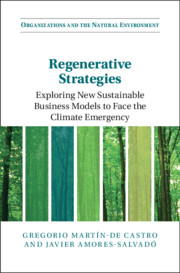Book contents
- Regenerative Strategies
- Organizations and the Natural Environment
- Regenerative Strategies
- Copyright page
- Contents
- Figures
- Tables
- Foreword: Reversing Course
- Acknowledgements
- 1 Introduction
- 2 Assessing the Response to the Climate Grand Challenge
- 3 Business as Usual
- 4 Sustainable Business Models
- 5 Climate Emergency in the Anthropocentric Era
- 6 The Regenerative Strategy
- 7 The Regenerative Strategy
- 8 Concluding Remarks
- Index
- References
5 - Climate Emergency in the Anthropocentric Era
Published online by Cambridge University Press: 28 March 2024
- Regenerative Strategies
- Organizations and the Natural Environment
- Regenerative Strategies
- Copyright page
- Contents
- Figures
- Tables
- Foreword: Reversing Course
- Acknowledgements
- 1 Introduction
- 2 Assessing the Response to the Climate Grand Challenge
- 3 Business as Usual
- 4 Sustainable Business Models
- 5 Climate Emergency in the Anthropocentric Era
- 6 The Regenerative Strategy
- 7 The Regenerative Strategy
- 8 Concluding Remarks
- Index
- References
Summary
Chapter 5 delves into the relationship between humans and the natural environment. It focuses on three key aspects: (1) the context, which provides an idea of the importance of humans in relation to the natural environment on which they depend; (2) the reasons why human intervention in the natural environment is considered to have led to the so-called Anthropocene era; and (3) the ways in which intensive human intervention has fundamentally altered the balances in the biosphere and the effects of that. Scientific evidence of several possible planetary emergency scenarios is shown to inform managers, entrepreneurs, investors, consumers and public policy decision-making.
- Type
- Chapter
- Information
- Regenerative StrategiesExploring New Sustainable Business Models to Face the Climate Emergency, pp. 114 - 138Publisher: Cambridge University PressPrint publication year: 2024



